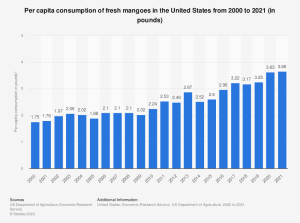A stone fruit grown from the tropical tree Mangifera Indica, mangoes are known for their delicious taste and nutritious value, both of which have contributed to their growing rise in popularity among U.S. Consumers.

“The U.S. population is diversifying, along with its tastes and preferences,” said Dr. Kimberly Morgan, associate professor of food and resource economics at the Southwest Florida Research and Education Center (SWFREC). “It’s culturally significant, and also, we want healthier fruits and vegetables, and mangoes taste good.”
Most mangoes are imported to the U.S., with large-scale production in the United States being limited. However, the warm, sunny climate does allow for mangoes to prosper in states such as Florida, where several of the most popular varieties today were cultivated through a seedling program initiated by the United States Department of Agriculture.
Dr. Morgan and Dr. Trent Blare, an assistant professor in Food and Resource Economics at the UF/IFAS Tropical Research & Education Center, are currently collaborating on a project funded by the National Mango Board examining market demand for fresh-cut mangoes.
Fresh-cut mangoes are a minimally processed product option where, instead of being sold whole, the fruit would be pre-cut and packaged before being sold to consumers at the store.
For fresh-cut mangoes to be processed and sold at large, there would have to be significant infrastructure investments. By conducting market research, Morgan, Blare and their colleagues will be able to determine what potential benefits there are to be had for producers by opening this new avenue of sales, so that they can better make decisions about investing in this new avenue.
“Going from selling the fresh fruit whole to selling it cut means facilities, staff, and refrigeration are needed,” Morgan explained. “Hopefully [our market research] can help them make decisions on what to invest.”
Morgan also moderated the National Mango Summit in Daytona Beach, Florida, in June, where Horticultural Scientists from UF/IFAS and researchers from Mexico provided updates on production trends, diseases, and marketing. Translation for Spanish Options was set up and an online option was also made available for participants to attend.
She also said that, in addition to research on marketing being done by UF/IFAS food and resource economists, there is also often research done by horticultural scientists at UF into breeding, disease prevention, and other best practices for grower success.
“It’s a great industry-academia partnership of bringing in a new crop, making sure it’s healthy, and understanding how it’s propagated and marketed.”
 1
1
